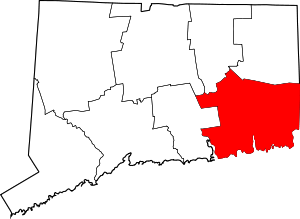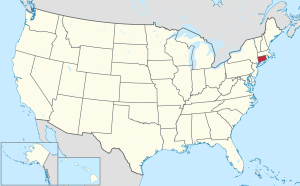New London County | |
|---|---|
County of Connecticut | |
 Former New London County Courthouse | |
 Location within the U.S. state of Connecticut | |
 Connecticut's location within the U.S. | |
| Coordinates: 41°28′N 72°06′W / 41.47°N 72.1°W | |
| Country | |
| State | |
| Founded | 1646 by John Winthrop, Jr. |
| Named for | London, England |
| Seat | none (since 1960) New London, Connecticut (before 1960) |
| Largest city | Norwich |
| Area | |
| • Total | 772 sq mi (2,000 km2) |
| • Land | 665 sq mi (1,720 km2) |
| • Water | 107 sq mi (280 km2) 13.8% |
| Population (2020) | |
| • Total | 268,555 |
| • Density | 403.8/sq mi (155.9/km2) |
| Time zone | UTC−5 (Eastern) |
| • Summer (DST) | UTC−4 (EDT) |
| Congressional district | 2nd |
New London County is a county in the southeastern corner of Connecticut and comprises the Norwich-New London, Connecticut Metropolitan Statistical Area, which is also included in the Hartford-East Hartford, Connecticut Combined Statistical Area. There is no county government and no county seat, as is the case with all eight of Connecticut's counties; towns are responsible for all local government activities, including fire and rescue, snow removal, and schools.
New London County contains reservations of four of the five state-recognized Indian tribes, although the Paugassett were historically located farther west. The population was 268,555 as of the 2020 census.[1]
On June 6, 2022, the U.S. Census Bureau formally recognized Connecticut's nine councils of governments as county equivalents instead of the state's eight counties. Connecticut's county governments were disbanded in 1960, and the councils of governments took over some of the local governmental functions. Connecticut's eight historical counties continue to exist in name only, and are no longer considered for statistical purposes.[2]
- ^ "Census - Geography Profile: New London County, Connecticut". United States Census Bureau. Retrieved November 20, 2021.
- ^ https://www.federalregister.gov/documents/2022/06/06/2022-12063/change-to-county-equivalents-in-the-state-of-connecticut Federal Register: Change to County-Equivalents in the State of Connecticut
